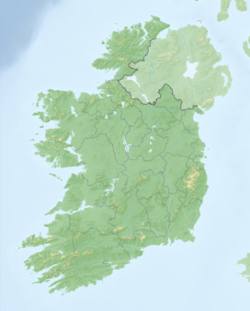Viking tombs of Dublin
Coordinates: 53 ° 20 ′ 31 ″ N , 6 ° 18 ′ 35 ″ W.
| Viking tombs of Dublin | ||
|---|---|---|
| location | Ireland | |
| Location | Dublin | |
|
|
||
| When | Viking age | |
| Where | Dublin | |
The Dublin Viking Tombs were first discovered in 1836 in Kilmainham , a borough of Dublin , Ireland . Other finds were made between 1842 and 1848 and in 1861 when a railway line and train station were built. Then again during the gravel mining in 1866 and during the creation of the First World War Memorial Park in 1933 to 1934.
Find description
There were two grave fields : one at the early Christian monastery "Cell Maignenn" (Kilmainham), the other about 800 m west at Islandbridge. In both cases, the Viking graves seem to have been laid on existing cemeteries, where burials were carried out according to the Christian rite - i.e. grave orientation east-west and without grave goods.
Kilmainham had at least 17 pagan Viking graves (with grave goods), of which 15 were male and 2 were female. There were also burials without gifts. At Islandbridge there were at least 19 pagan Viking graves, 17 male and 2 female. Islandbridge is next to an old ford across the river. The grave goods contained a large number of:
- Weapons: ax blades, lance tips, knives, shield bosses, swords,
- Devices: needles, tweezers , spindle whorls , scissors and sickles, pliers
- Commercial items: scales and weights
There were other grave finds in the area, the exact location of which is unknown, but which belong to at least 20 other pagan Viking graves, 16 male and 4 female. All artifacts date from the 2nd half of the 9th century, which coincides with the founding of Longphort of Dublin in 841 and the residence of the first Vikings until the early 10th century.
The Christian cemeteries with the pagan burial grounds are located on a two-kilometer gravel ridge between the rivers Camac and Liffey and the monastery, which was probably surrounded by walls. The ford nearby was suitable for landing boats and an ideal location for a longphort. The Vikings are known to spend the winter in monasteries after or before raids. It was also common for them to bury their dead in cemeteries.
It has been suggested that the ford is Áth Cliath (the Irish name for Dublin is Baile Átha Cliath - "city on the hurdle ford"). It is above the high tide. The point, usually identified as Áth Cliath, on the other hand, is two kilometers downstream. It is about 300 meters wide with tidal flats on the sides. The cemeteries seem to show that a community of Vikings lived on the monastery grounds between Kilmainham and Islandbridge. It is of course possible that at the same time (or initially) there was another Longphort further downstream at Duiblinn . Little productive excavations took place at Wood Quay on the Liffey. Two traditions from the years 841 and 842 speak of a Longphort near Dubhlinn, but the following all refer to Áth Cliath.
literature
- Barry Cunliffe : Facing the Ocean. The Atlantic and its peoples. 8000 BC - AD 1500. Oxford University Press, Oxford et al. 2001, ISBN 0-19-924019-1 .
Remarks
- ↑ A Longphort (Irish, plural: Longphuirt ) is a term used in Ireland for a Viking ship pier or port.
Web links
- Finds (English)
